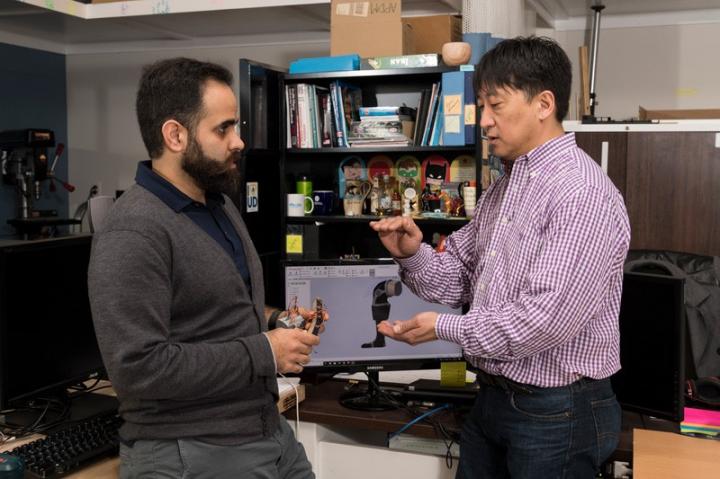Research Team Granted $200K to Develop Artificial Muscle-based Orthotic Device for CP Children

Ahad Behboodi, a UD doctoral candidate and the project principal investigator, and Prof. Samuel Lee discuss how the artificial muscle will function in the proposed medical device. CREDIT University of Delaware/ Kathy F. Atkinson
A University of Delaware (UD) research team was awarded $200,000 to develop a prototype leg brace that uses innovative artificial muscle technology for children with cerebral palsy, a press release announced.
The grant is provided by the QED proof-of-concept program, which is run by the University City Science Center in Philadelphia. In addition to funding, the QED program will give the researchers mentoring and business advice to commercialize this early-stage healthcare technology.
Orthotic devices — artificial supports or braces for the limbs or spine — for children with cerebral palsy are meant to improve or preserve their independence in movement and balance. Most cerebral palsy children go through several orthotic devices in hopes of improving their mobility and stability.
But commonly used orthotic devices often include a stiff plastic cover that stabilizes the foot at the expense of the leg’s mobility and flexibility. Consequently, children with cerebral palsy using these traditional orthotic devices are susceptible to weakening and atrophy of leg muscles over time due to inactivity.
“Having an active device that can assist children with cerebral palsy potentially can minimize this atrophy, because now the muscle is going through a range of motion,” said Samuel Lee, PhD, co-principal investigator and adviser to the project’s lead, graduate student Ahad Behboodi.
An everyday challenge that a child with cerebral palsy runs into is raising his or her toes and feet to clear obstacles on the ground such as a curb. Devices are needed that can assist the front calf muscles in lifting the ankle up.
To help children with cerebral palsy move freely under their own power, the UD team created a small, lightweight apparatus that imitates the leg’s actions. This new mechanical ankle brace is the first lower limb device designed to correct alignment or provide support using soft muscle-like “smart materials” made with simple, off-the-shelf elastic parts that contract when stimulated with an electric current.
The inspiration for the wearable ankle-foot device grew out of Behboodi’s graduate work with Lee, who is an associate professor in UD’s department of physical therapy. They developed a method for modeling how children with cerebral palsy walk to implement appropriate assistive devices for stimulating specific muscles.
To make the device a reality, they brought in Martha Hall, director of the Innovation for Design Lab, and Eliza Arch, PhD, assistant professor in the department of kinesiology and applied physiology, both of whom are experts in wearable technology and design.
Together, the research team is in the process of completing a prototype. To do so, they are developing the artificial muscle technology, finalizing the leg-mimicking software, and refining the brace’s design to make it suitable for the real world and wearable for children.
“We must think about what is functional, comfortable and acceptable for children,” Hall said. “If we create something cool in the lab and it’s not really useful to a child outside the lab setting, it’s not going to be used.”
The researchers said they eventually want the brace to be used to enable cerebral palsy children to exercise. In this case, the artificial muscle would have to push back against the child’s movements to strengthen or stretch muscles to increase mobility and flexibility.
“For now, the device can only assist the wearer’s own muscle contractions but we are able to customize where we put the force to change the movement,” Behboodi said. “In the future, we may add functional electrical stimulation technology, which is a major area of research in Dr. Lee’s lab, to also trigger muscles, when needed. This would improve the timing and power of the muscle’s activation, thereby strengthening the muscle and improving the user’s walking coordination.”
Besides the UD team, the QED program awarded grants to three other teams to aid in the commercialization of their life science and healthcare innovations.
“Our job doesn’t end until the innovation advances to a final product and gets integrated into the market,” said Joy Goswami, assistant director of technology transfer at UD.


